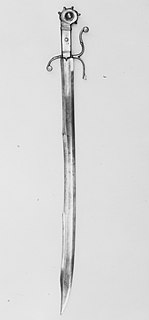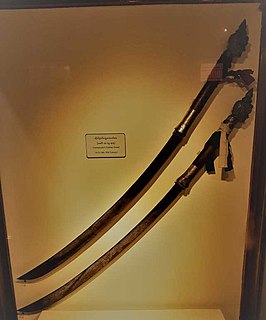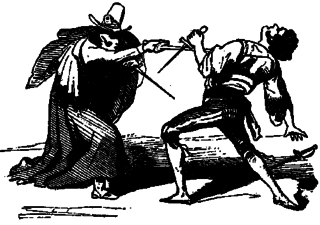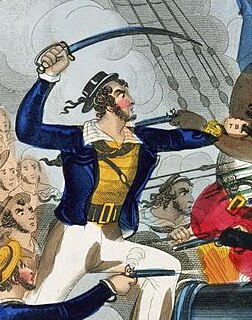A sword is an edged, bladed weapon intended for manual cutting or thrusting. Its blade, longer than a knife or dagger, is attached to a hilt and can be straight or curved. A thrusting sword tends to have a straighter blade with a pointed tip. A slashing sword is more likely to be curved and to have a sharpened cutting edge on one or both sides of the blade. Many swords are designed for both thrusting and slashing. The precise definition of a sword varies by historical epoch and geographic region.

A falchion is a one-handed, single-edged sword of European origin. Falchions are found in different forms from around the 13th century up to and including the 16th century. In some versions, the falchion looks rather like the seax and later the sabre, and in other versions more like a machete with a crossguard.

The hilt of a knife, dagger, sword, or bayonet is its handle, consisting of a guard, grip and pommel. The guard may contain a crossguard or quillons. A tassel or sword knot may be attached to the guard or pommel.
A longsword is a type of European sword characterized as having a cruciform hilt with a grip for two-handed use, a straight double-edged blade of around 85 to 110 cm, and weighing approximately 1 to 1.5 kg.

Dao are single-edged Chinese swords, primarily used for slashing and chopping. The most common form is also known as the Chinese sabre, although those with wider blades are sometimes referred to as Chinese broadswords. In China, the dao is considered one of the four traditional weapons, along with the gun, qiang (spear), and the jian, called in this group "The General of Weapons".

A cutlass is a short, broad sabre or slashing sword, with a straight or slightly curved blade sharpened on the cutting edge, and a hilt often featuring a solid cupped or basket-shaped guard. It was a common naval weapon during the early Age of Sail.

The English language terminology used in the classification of swords is imprecise and has varied widely over time. There is no historical dictionary for the universal names, classification or terminology of swords; A sword was simply a double edged knife.

The term kopis in Ancient Greece could describe a heavy knife with a forward-curving blade, primarily used as a tool for cutting meat, for ritual slaughter and animal sacrifice, or refer to a single edged cutting or "cut and thrust" sword with a similarly shaped blade.

A dusack is a single-edged sword of the cutlass or sabre type, in use as a side arm in Germany and the Habsburg Monarchy during the 16th to 17th centuries, as well as a practice weapon based on this weapon used in early modern German fencing.

In martial arts, a waster is a practice weapon, usually a sword, and usually made out of wood, though nylon (plastic) wasters are also available. Nylon being much safer than wood, due to it having an adequate amount of flex for thrusts to be generally safe, unlike wooden wasters. Even a steel feder has more flex than most wooden wasters. The use of wood or nylon instead of metal provides an economic option for initial weapons training and sparring, at some loss of genuine experience. A weighted waster may be used for a sort of strength training, theoretically making the movements of using an actual sword comparatively easier and quicker, though modern sports science shows that an athlete would most optimally train with an implement which is closest to the same weight, balance, and shape of the tool they will be using. Wasters as wooden practice weapons have been found in a variety of cultures over a number of centuries, including ancient China, Ireland, Iran, Scotland, Rome, Egypt, medieval and renaissance Europe, Japan, and into the modern era in Europe and the United States. Over the course of time, wasters took a variety of forms not necessarily influenced by chronological succession, ranging from simple sticks to clip-point dowels with leather basket hilts to careful replicas of real swords.
The baselard, Schwiizerdolch in Swiss-German is a historical type of dagger or short sword of the Late Middle Ages.

Seax is an Old English word for "knife". In modern archaeology, the term seax is used specifically for a type of small sword, knife or dagger typical of the Germanic peoples of the Migration period and the Early Middle Ages, especially the Saxons, whose name derives from the weapon. These vary considerably in size.

The Oakeshott typology is a way to define and catalogue the medieval sword based on physical form. It categorises the swords of the European Middle Ages into 13 main types, labelled X through XXII. The historian and illustrator Ewart Oakeshott introduced it in his 1960 treatise The Archaeology of Weapons: Arms and Armour from Prehistory to the Age of Chivalry.

The shashka or shasqua, is a kind of sabre; single-edged, single-handed, and guardless backsword. In appearance, the shashka is midway between a typically curved sabre and a straight sword. It has a slightly curved blade, and can be effective for both cutting and thrusting.

A kalis is a type of double-edged Filipino sword, often with a "wavy" section. The kalis has a double-edged blade, which is commonly straight from the tip but wavy near the handle. Kalis with fully straight or fully wavy blades also exist. It is similar to the Javanese keris, but differs in that the kalis is a sword, not a dagger. It is much larger than the keris and has a straight or slightly curved hilt, making it primarily a heavy slashing weapon.

Dha is the Burmese word for "knife" and "sword" similar term to daab or darb in Thai language for a single edge sword. The term dha is conventionally used to refer to a wide variety of knives and swords used by many people across Southeast Asia, especially present-day Myanmar (Burma), Thailand, Yunnan, Laos, Cambodia and Vietnam.

The parrying dagger is a category of small handheld weapons from the European late Middle Ages and early Renaissance. These weapons were used as off-hand weapons in conjunction with a single-handed sword such as a rapier. As the name implies they were designed to parry, or defend, more effectively than a simple dagger form, typically incorporating a wider guard, and often some other defensive features to better protect the hand as well. They may also be used for attack if an opportunity arises. The general category includes two more specific types, the sword breaker and trident dagger.

The khanda is a double-edge straight sword originating from the Indian subcontinent. The Rajput warrior clans venerated the khanda as a weapon of great prestige. It is often featured in religious iconography, theatre and art depicting the ancient history of India. It is a common weapon in Indian martial arts. Khanda often appears in the Sikh, Jain, Buddhist and Hindu scriptures and art.

The Wallace Sword is an antique two-handed sword purported to have belonged to William Wallace (1270–1305), a Scottish knight who led a resistance to the English occupation of Scotland during the Wars of Scottish Independence. It is said to have been used by William Wallace at the Battle of Stirling Bridge in 1297 and the Battle of Falkirk (1298).

Ratings of the Royal Navy have used cutlasses, short, wide bladed swords, since the early 18th century. These were originally of non-uniform design but the 1804 Pattern, the first Navy-issue standard cutlass, was introduced at the start of the 19th century. This was a bluntish weapon that was perhaps intended for cutting away canvas and ropes rather than as a thrusting combat weapon. The 1845 Pattern cutlass introduced a bowl-style hand guard which provided greater protection, with a longer and more curved blade. Its sharper point made it more useful for thrusting attacks, which were now emphasised in the drill manual. The 1845 Pattern was modified several times including shortening and straightening the blades, which weakened them. The 1889 Pattern had a straight, spear-pointed blade with a hilt that curved outwards to catch and redirect an opponent's sword point. The 1900 Pattern, the last navy-issue cutlass, was similar to its predecessor with the introduction of a fuller and a hilt insert that cushioned the user's little finger. The cutlass was withdrawn from service in 1936 but remains in use for ceremonial purposes. It is thought that it was last used in combat in 1900 during the Boxer Rebellion.


















